How to transplant a cactus correctly?

It is believed that caring for cacti is almost minimal. Of course, when you compare them to the more capricious houseplants, the difference is obvious. But even in this simple matter there are some "pitfalls" that you must be aware of. A cactus, which is properly looked after, lives for more than a dozen years. But in reality, few plants really last that long. Here it is necessary to competently carry out all stages of care. The transplant deserves special attention - this is a kind of basis on which the further well-being of the plant depends.
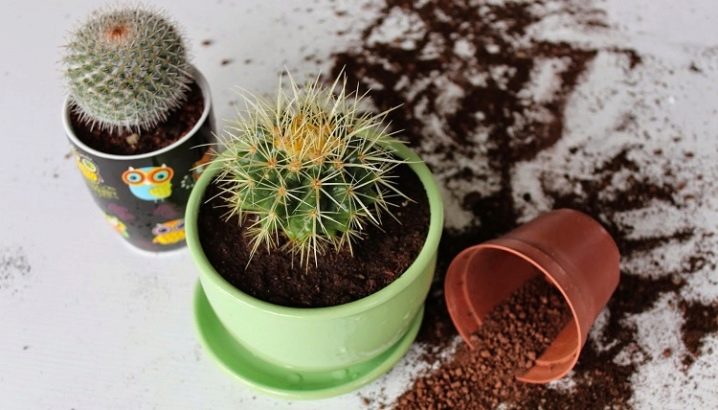
Peculiarities
Strictly speaking, there are few reasons for transplantation, consider each one is more detailed.
- The cactus is often transplanted after purchase. Not everyone likes the look of the pot, and it often turns out that during his time in the flower shop, he simply outgrew it. In addition, buying a cactus by hand, and not in a store, no one can guarantee that it was planted as it should. Therefore, while the plant remains healthy, it must be arranged according to all the rules. So there will be fewer reasons for concern about the future fate of the plant.
- Cacti need to be replanted at a specific frequency. This is done to prevent various diseases. In addition, the pot needs to be changed gradually as it grows. A container that is too large will cause excess moisture to accumulate. And too little slows down growth.
- In the process of cactus growth, emergency situations arise when a transplant is simply necessary. This can be a trivial fall, which will result in the replacement of the pot. It is much worse if the cactus itself gets damaged. But even in this case, some part of it can be saved. Other indications for transplantation are diseases. Most often, a soil change is needed, and sometimes the removal of damaged roots and trunk. In most cases, the outcome is quite favorable.
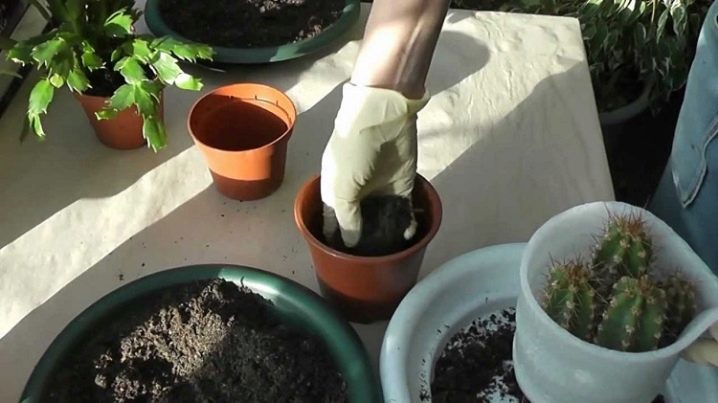
The planned procedure has its own characteristics. This is due to the fact that the transplant process consists of several stages:
- search and processing of tools;
- plant preparation;
- direct transplant;
- observation and care.
Even the process of buying a cactus is never spontaneous.
In the case of suddenly arising problems, it is the need to do everything quickly and the lack of the necessary tools that leads to errors.
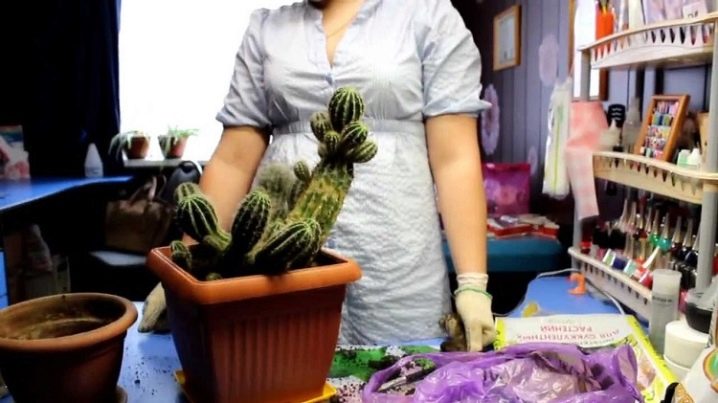
Time and frequency
The frequency of replanting is almost always associated with the growth of the cactus. If it develops quickly, you can transplant at least every year. At the same time, an indicator that this pot has exhausted itself will not be the root peeking out of the lower hole, but a slowdown in growth. In addition, there may not be enough moisture in a small pot. In this case, the plant will have a shriveled, but dense trunk (if the trunk is soft, this is a symptom of a serious disease, and not a lack of water).
A healthy, adult cactus needs preventive replanting every three years. But for a perennial plant, these intervals can be extended - the older the age, the more painful the transplant process will be for it. There are subtleties here.
There is controversy over the time of year. The period of late winter or early spring is considered optimal. Here it will be easier for the cactus to adapt due to the increase in daylight hours. But if you made a purchase in the fall or summer, don't wait.
The only period when you need to abstain is when the buds appear and flowering. Even on ordinary days, cacti do not tolerate the hustle and bustle. They do not tolerate loosening, frequent movement and other manipulations. Experienced flower growers advise to note the side with which it faces the sun, and not to turn the pot once again.
Only strict adherence to the rules allows you to achieve beautiful flowers from especially capricious varieties.
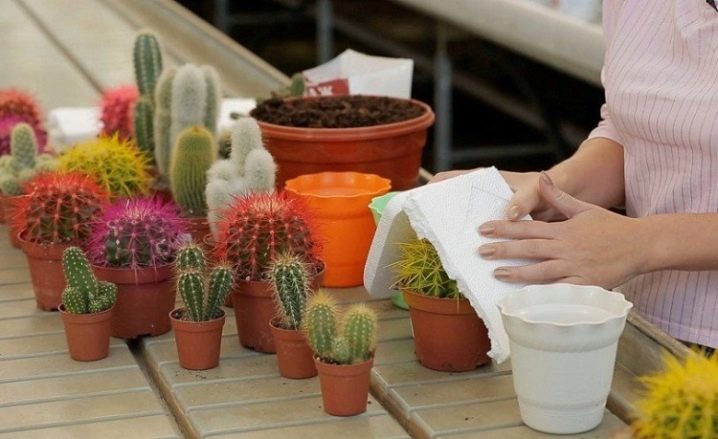
What is necessary?
To transplant a cactus at home, you will need:
- pot;
- drainage and soil mix;
- scissors or a sharp knife (you can take a garden, clerical, or replace it with a regular blade);
- hand protection - gloves or foam rubber;
- a narrow scoop for sprinkling the earth or a spoon.
The choice of a pot requires special attention. Its size depends on the parameters of the cactus and the length of the roots - for spreading, but short, depth is not too important. Most varieties have rather long roots, so the container must be of the appropriate depth. The diameter of the pot should be a couple of centimeters larger than the width of the cactus. Any plastic or ceramic container can be used. The main thing is that there are holes at the bottom. Without them, moisture will stagnate, and this is fraught with the development of diseases. In addition, bottom irrigation can be used through them. Be sure to check the stability of the pot. Its weight, together with the soil, must be sufficient to prevent overturning.
A new pot must be disinfected with potassium permanganate and dried before use.

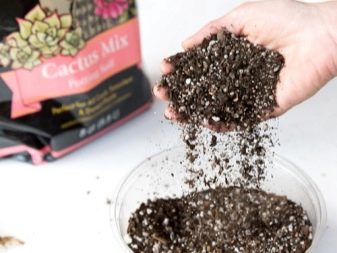
The filling of the pot must be correct, for this use the following step-by-step instructions.
- Any drainage stones are placed on the bottom: expanded clay, gravel and the like. As a last resort, you can use broken foam. The thickness of this layer usually occupies a quarter or a third of the internal volume.
- Then comes the ground. It is a special blend. Its components must be loose enough so that air and water can flow well to the roots. A similar primer is sold in all shops for flower growers. If you do it yourself, in equal parts you will need leafy soil, sod cleared of grass, coarse sand and very little peat. The sand and drainage must be rinsed in a manganese solution and dried. All other components should be baked in the oven. Do not neglect these procedures so as not to introduce pests into the soil. To make the soil looser, you can add polystyrene peas to it.
- A layer of pebbles is again placed on top. Drainage or colored decorative will do.

Before transplanting a cactus, it is necessary to carefully study the information about the size of the plant at different periods of its life, growth rate, type of root system and rules of care. Everything you need for transplanting can be purchased at the store, along with the cactus.
Here you can also use the seller's advice on issues of interest.
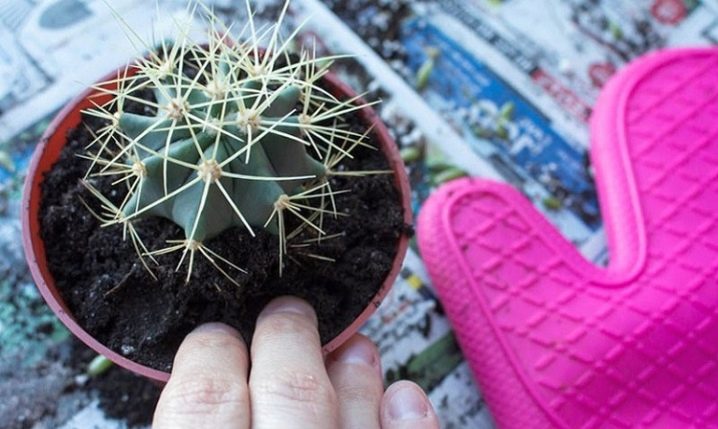
How to transplant?
The transplant procedure does not require special skills and is quite simple. It can even be entrusted to a schoolchild, having previously instructed about the danger of needles. The stages and methods of transplanting are slightly different depending on the size of the cactus, its root system and damage.

Small
Very tiny "cactus" deserve the greatest care. They are grown from seeds, building a kind of greenhouse with a film and bottom irrigation. A couple of weeks after germination, they can already be transplanted. Each plant is gently picked up with tweezers and placed in a hole, and then lightly press the soil around. Until they reach the age of one, they are transplanted as they grow, every two or three months.
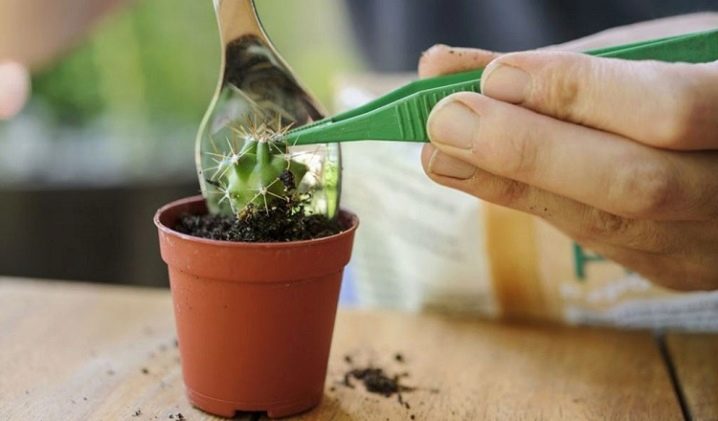
Transplanting an already grown cactus almost always follows the same step-by-step scheme.
- To begin with, the cactus is removed from the container. If the pot is plastic, you can simply wrinkle it so that the soil falls behind the walls. They also help in this matter with any thin objects.
- After removing the roots, you need to get rid of the old soil. To do this, the lumps can be picked manually.If this cannot be done or there is a risk of damaging the roots, you can resort to soaking in water. Only then the cactus must be dried in the air for a couple of days. Root cleaning is needed to assess the condition of the root system. The sooner damage is noticed, the better. The affected areas, if any, are removed with a knife or scissors. The wounds can be powdered with crushed activated carbon or simply dried.
- While the cactus dries up, fill the pot. Drainage and some soil should be placed in it. Then the cactus is placed there. It should be held in such a way that the neck is an inch below the edge of the pot. After filling the soil, you can add pebbles, sand or do without them on top.
It is believed that watering is not needed in the first 5-7 days after transplanting.
If it is too hot in the house or the sun is shining actively, turn on a humidifier next to the plant in the morning and evening.
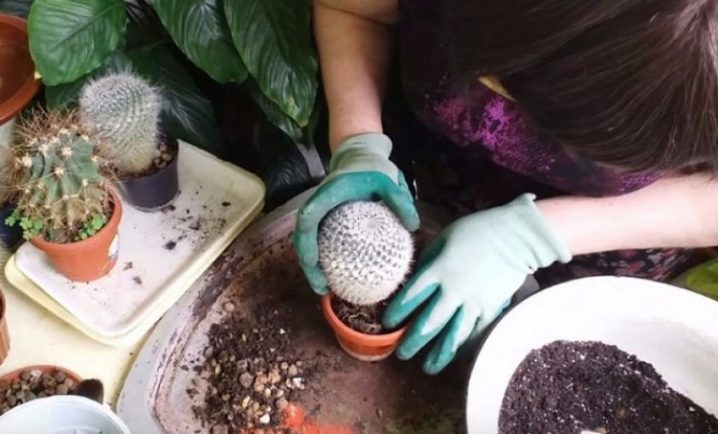
Big
The larger the cactus, the greater the chance of injury. After all, there are very high or, conversely, low, but voluminous varieties. Let's consider what to do in this case.
- The pot along with the plant is laid on its side. In order not to wrinkle thorns or leaves, you need to put foam rubber or a soft cloth under them.
- The container is tapped or pushed off with chopsticks, and then carefully removed. Do not move the cactus.
- Then you need to free the roots. It is believed that perennial cacti can be transplanted while retaining most of the earthy clump. If there are no visible problems, and they did not arise during transplantation earlier, then this is quite acceptable.
There are two ways to place a cactus in a prepared pot.
- If there is an assistant, we act as if we were small. Prepare the pot with the lower layers, hold it in the center and add soil on the sides.
- If the cactus is hard to hold, let's use the following tip. We pour drainage and soil up to half the pot, tilt it and move it closer to the plant. The soil inside forms a slide, which must be leveled, spread the roots, and add the soil mixture as much as possible. And then place the cactus with the pot in an upright position and fill to the required level.
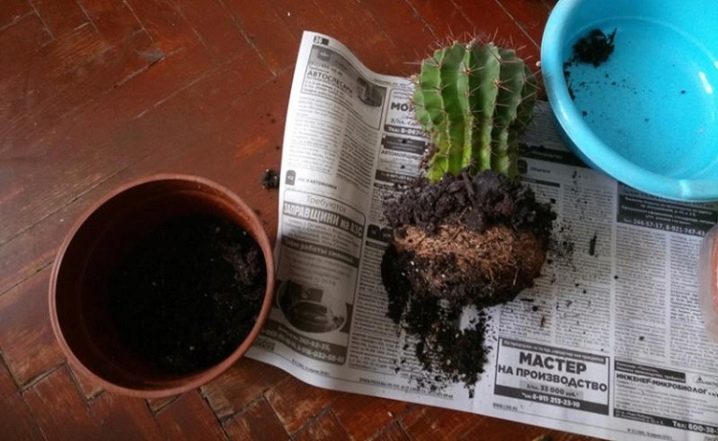
No roots
Often the cactus breaks down and a part of it needs to be planted or the roots are lost due to diseases. If children are to be planted, then it is worth considering that not all of them have roots. In this case, it is necessary to slightly sharpen the lower part of the process, while trying not to touch the center. The cut should air dry - it will take several days. Then the cactus can be planted immediately in the ground and wait for rooting. But keep in mind that it can rot. It is much safer to wait for the roots to appear, and only then start planting. This can be achieved in two ways, each of which has its own supporters.
- Set the cactus with a cut on wet sand. To prevent it from falling, you can make supports from sticks.
- Dip into a narrow container of water. But so that there is a small distance between the cut and the water. You can't just put the plant in water.
After the roots appear, you can start planting. In a filled flower pot, you need to make a commensurate depression and cover it with soil.
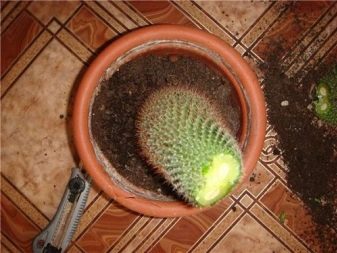
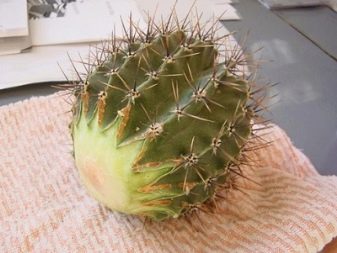
Barbed
All cacti need to be replanted. Transplanting varieties with thorns is no different. But injections shouldn't be underestimated. Because, in addition to the pain of the injection, there may be other consequences. The thorn can break and remain under the skin, and then a rather painful procedure to remove it follows. Cacti with thin, frequent thorns are especially dangerous.
When pierced into the skin, they begin to hurt immediately and cause inconvenience every time you pick up something. It is very difficult to extract them.
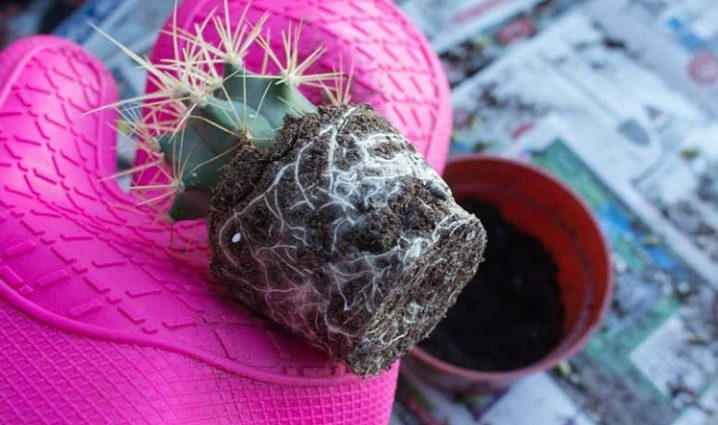
In addition, an infection can get into the wound. Therefore, when transplanting, you must follow all precautions: be sure to get tight rubber gloves and use various devices:
- tweezers - in order not to crush the cactus, it is better to take it by the neck;
- foam rubber - even ordinary dishwashing sponges are suitable;
- folded fabric, with which you can gently wrap the plant;
- a strip of cloth, paper or other suitable material - it is tightly wrapped around the cactus and the ends are fixed with your fingers, thus, a kind of holder is obtained.
However, those who decide to seriously engage in breeding should pay attention to the tongs specially designed for this purpose. At their end there are brushes that will not damage the cactus. And the comfortable handle will save you energy.
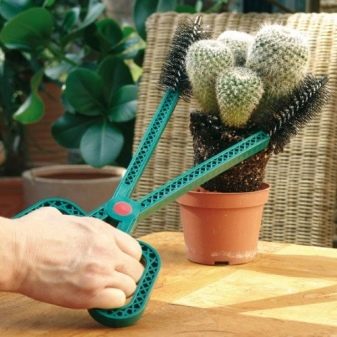

Possible problems
Once transplanted, the cactus may look great. However, even seemingly healthy plants need to be inspected periodically. After all, the sooner you discover a problem, the easier it is to fix it. Moreover, the problems may relate not only to the state of the plant, but also to the soil. For example, it can sag on one side. This is due to the uneven filling of the pot. To avoid subsidence, the pot must be shaken periodically while filling, but never tamped.
The sagging place must be filled so that the cactus does not fall over.
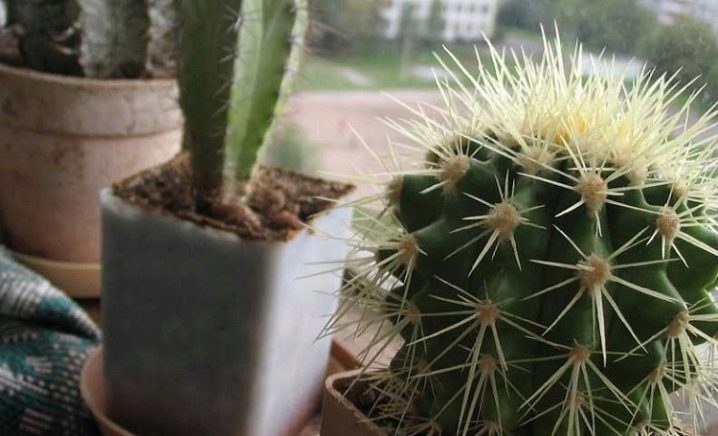
When examining a cactus, you should be alerted by some points.
- The appearance of wrinkles... If the trunk is still hard, it may be lacking moisture. If the trunk is soft, this could be the onset of the disease.
- Lack of growth. If growth has stagnated or not, the soil may be lacking nutrients. You can use fertilizers (except nitrogenous).
- Cracks... They are usually associated with an oversupply of fertilizing.
- Spots, discoloration, plaque. All this can be a sign of an infectious or bacterial disease, as well as the appearance of parasites.
- Loss of elasticity. Sometimes a tall cactus can begin to lose its shape and bend to the side. Most often, in such cases, there is a problem with the roots - they are the most vulnerable. For example, they can rot from excessive watering.
If the appearance of the cactus has changed, do not wait. You need to immediately transplant, completely replacing the soil. At the same time, the cactus itself also gets rid of the affected areas and is processed.
After transplanting, you can resume watering with medicinal solutions.
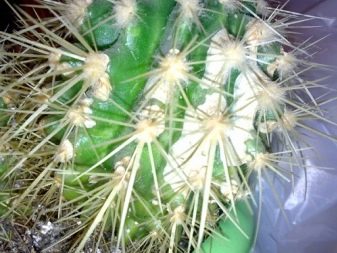
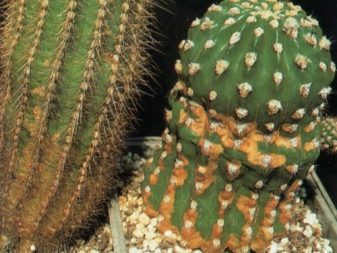
Follow-up care
Watering after transplanting is prohibited. The rest of the time, the question of its necessity should be decided based on the variety of cactus and the conditions for its maintenance. Plants that came to us from the conditions of the rainforest, and at home, need appropriate conditions. In contrast to them, the desert "congeners" have a low demand for moisture. The frequency of watering is due to the changing seasons. In December, when daylight hours are short and all processes in the plant slow down, watering is not needed. In general, in autumn and winter, this should be done no more than once a month and a half. At the same time, cacti must be protected from heating devices, which dry out the air very much.
In the spring and summer, you need to water more often - about once a week. You can use a dry stick to pierce the ground near the side of the pot. If it is completely dry, then the soil should be moistened. For desert cacti, bottom watering (through drainage holes) is often advised. But you cannot leave water in the pan for a long time.
In general, in the case of cacti, it is better to underfill than overflow.
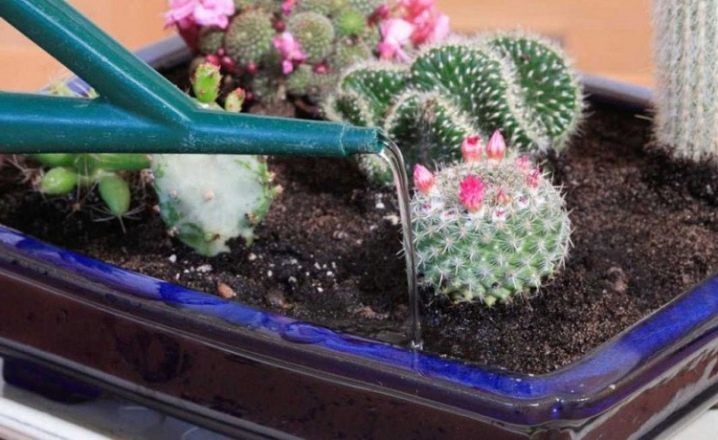
For watering, you need a watering can with a long, narrow spout. The water must be supplied so that drops do not remain on the cactus trunk, otherwise stains may appear. For the same reason, spray irrigation should be very shallow. Chlorinated and hard water will not work. But even clean water must be boiled and cooled. It is not too troublesome due to the rarity and moderation of watering.
As in caring for any plants, constant air exchange is important in this case. But you need to ventilate carefully, without drafts. In summer, cacti can be placed on a closed balcony.
But in the hours when the sun is most active, it is better to shade them so that there are no burns.
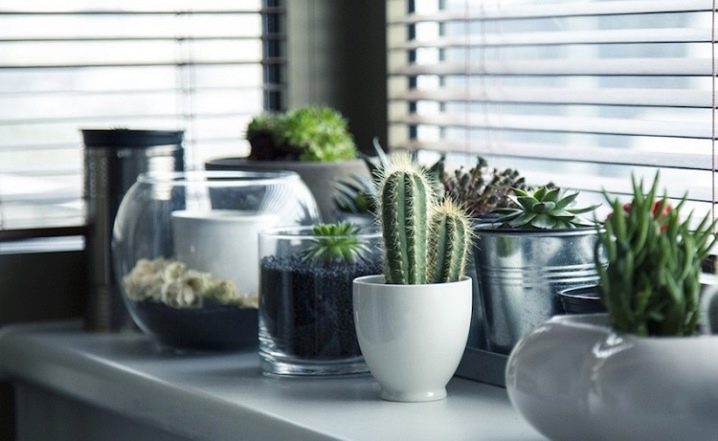
You can find out how to properly transplant a cactus by watching the video.























































The comment was sent successfully.